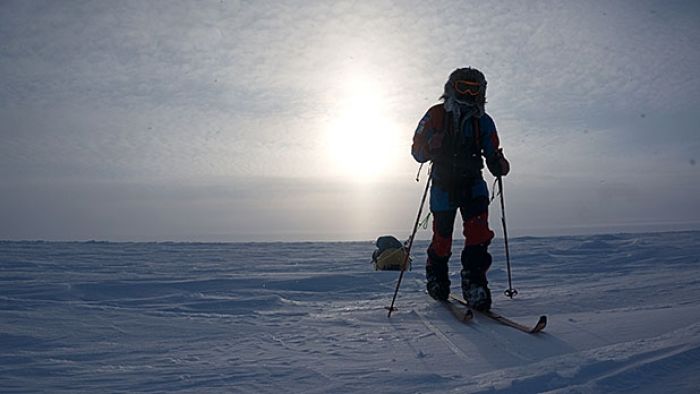The Last North: A Polar Expedition Never to Be Repeated
Credit: Photographs Courtesy Animal Planet
Snow, ice, cold. Snow, ice, cold. That's how polar explorer Eric Larsen describes his many trips to some of the most extreme corners of the planet — the North and South poles and the top of Mt. Everest, among them. In March 2014, Larsen and teammate Ryan Waters embarked on 53-day slog from the northern tip of Canada's Ellesmere Island to the geographic North Pole, a distance of some 500 miles. The expedition was entirely unsupported, meaning that Larsen and Waters carried all of their gear and supplies for the entire trip in two modified sleds, which they drug behind them. When they first set off from land, each one weighed an almost immovable 320 pounds.
"We literally couldn't pull them to start," Larsen says. "We both had to tie up to one, pull it a hundred meters or so, then go back for the other one — so to make one kilometer we had to walk three."
RELATED: Eric Larsen and Ryan Waters Set a New Arctic Speed Record
The trip distinguishes itself from all other Arctic trips by the fact that it is likely to be the last unsupported expedition to the North Pole to set off from land. Shrinking ice and shorter winter seasons mean there's longer enough solid ice for long enough to travel that distance. Plus, the one air service that rescued stranded explorers, providing a safety net, however limited, discontinued their North Pole service after Larsen and Waters' trip. The Last North Expedition, as the team called it, is perhaps the most accurately named adventure in exploration history.
On Wednesday, December 9th, at 9 p.m. the expedition gets primetime treatment on Animal Planet. The two-hour special follows the duo as they inch along their route, getting stalked by a polar bear at one point and swimming through giant breaks in the ice to continue their progress. The footage from the expedition, shot by Larsen and Waters themselves, does an impressive job of showing just how demoralizing the fight against the slow southern drift of the ice flow became for the two. (Many mornings Larsen and Waters would wake up to realize they had drifted a mile south during the night.) The show also does a good job of making the very long and monotonous adventure compelling.
This exclusive clip from the Animal Planet special (airing Wednesday, December 9, at 9 p.m.) shows what happens to Eric Larsen and Ryan Waters when the thin ice gives out.
"Many days, when it was whiteout conditions," says Larsen, "it felt like being in a ping-pong ball."
From the first day it was unclear if the team would make it. The pack ice had smashed together as it rammed the shoreline of Ellesmere Island, creating miles and miles of what were essentially boulder fields made up of jagged ice, and the team had to push and pull their sleds over and around them. After a week out, the two had only made it a few miles.
As they got within striking distance of the Pole, within one degree of latitude, they had to decided whether to abandon their trip or break into their emergency rations and risk starving if a plane couldn't pick them up as soon as they reached the pole. The decision now seems like an easy one, but at the time the result could have gone either way.
"At some points, making a decision became the hardest part," says Larsen.
 (Larsen's face covered in snow and ice.)
(Larsen's face covered in snow and ice.)
Get the latest in gear, fitness, travel & more delivered directly to your inbox. Sign up now for the Men’s Journal newsletter.
